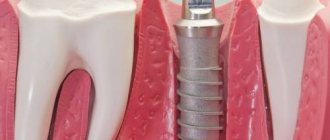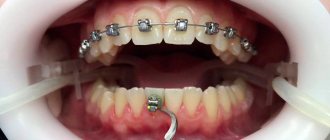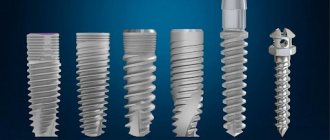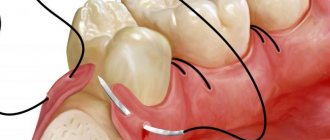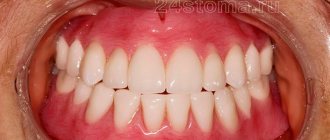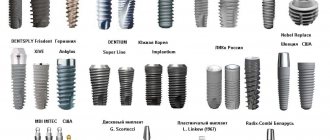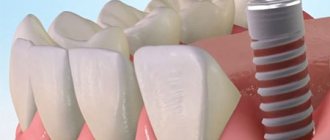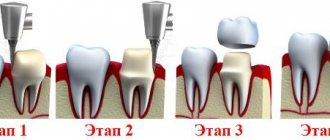This material contains answers to questions that patients most often ask when installing dental implants. Having received the most complete information on this matter, you will be able to understand in more detail what the treatment is, what guarantees they can give you, whether there are risks, etc. The most common questions are answered by experienced experts in the field of dental implantation.
Question #1: What is an implant?
Implant (or implant) is an artificial titanium pin (root) that is screwed into the hard jaw bone, thereby replacing the natural tooth root. The implant also includes an abutment (connecting link) and the crown itself, which performs the functions of a tooth. This is a ready-made solution that can completely replace your dental unit - in function, appearance and feel. The main advantage of the implant is that it can stand “independently”, that is, unlike the same bridge, neighboring teeth are not cut down.
Using an implant, you can restore one, two or more teeth in a row, as well as at least all 32 units. The implant can also serve as a support for a future denture (for example, as is the case with the All-on-4 or All-on-6 systems).
What if you install removable dentures on implants?
Some patients, due to financial capabilities, personal considerations or other circumstances, want to have removable dentures on implants. In fact, this solution is better than a completely removable one, since it allows you to securely fix more compact orthopedic structures and eliminate the possibility of them falling out of the mouth. But it is definitely worse than non-removable, since it is considered short-lived and imposes restrictions on the hardness of the food consumed (you have to eat mostly soft dishes).
Photo: implant-supported dentures
How many implants can be installed in the jaw in this case? Optimal for the lower jaw – at least 4 pieces. For the upper one - at least 6. However, in order to make treatment cheaper, many patients agree to only 2 pieces of artificial roots installed on one of the jaws. Such a solution is acceptable, but we cannot talk about its full functionality. The less “support” there is, the more discomfort and less durability.
Question 2: Are there any contraindications for the implantation procedure?
Yes, I have. But every year there are fewer and fewer of them. Dentistry is rapidly developing, trying to make implantation more accessible, including to those people who could have been denied such manipulation just a few years ago.
The following are considered absolute contraindications:
- diseases of the central nervous system;
- severe forms of diabetes;
- cancerous tumors;
- systemic bone lesions.
Relative contraindications include:
- viral infections and inflammatory processes;
- pregnancy and lactation;
- poor oral hygiene.
Professional installation of dental implants
You can insert high-quality dental implants. Price
for the implantation procedure depends on the chosen technique and material. The staff includes high-profile specialists with extensive professional experience.
To restore the dentition, high-quality titanium implants from trusted manufacturers are used, showing a high survival rate with minimal risks of complications.
Our center regularly holds promotions and special offers. There are discounts for citizens of preferential categories. An additional 3% discount on any dental procedures is provided to all patients who leave their reviews on the site (summed up with other discounts available to the client).
Write, share your experience and receive a pleasant bonus that will allow you to save a lot of money on medical procedures at the center of modern dentistry “Aesthetics”!
Question 3: Is it possible to place an implant immediately after tooth extraction?
Yes, you can. This procedure is called one-stage implantation, when a titanium root is implanted immediately after the extraction of its tooth. But there is one important condition here - the patient must have enough volume of hard bone for the pin to be successfully implanted and take root. If there is a lack of bone tissue, then most likely the surgeon will offer a classic scheme with preliminary bone augmentation.
The presence of inflammation also plays a role. If an inflammatory process is diagnosed in the area of the tooth being removed, the soft tissues are first treated, and only then preparations are made for the implantation of a new tooth.
It is important
! By saving a few months or “turning a blind eye” to inflammation, all the work to restore teeth may come to naught. It is much better to wait until the skeletal system and soft tissues are ready to accept the foreign body (and the implant is a foreign body) so that the process is completed with 100% success.
For front teeth
Implants for the anterior regions must meet high requirements, and therefore they must be selected as carefully as possible. Primary requirements:
- optimal length and compact diameter for easy implantation;
- made of zirconium dioxide, so they will not show through the gums;
- Different sized threads at bottom and top for stability.
By choosing a suitable implant, a specialist can preserve the maximum amount of bone tissue, avoiding its loss. When working in the smile zone, a one-stage version of the procedure is used with the use of a temporary prosthesis or crowns on the day of implantation.
Question 4: Is it possible to install several implants at once?
Yes, you can. But quantity plays a role. For example, surgeons place one or two artificial roots at a time.
It is always worth remembering that implantation is a surgical intervention and stress for the body. In order not to overload your health, the surgeon draws up an implantation calendar, where he clearly states the dates of operations. This will distribute the load on the body.
Note! There is no need to rush to insert all the missing teeth at the same time. Let this process be systematic. By waiting a few months, you will receive guarantees that the roots will take root reliably and withstand all the load that will fall on them.
Question 5: Are there any age restrictions?
There are practically no age restrictions for dental implantation. Implants are allowed to be placed in young patients after the final formation of the dental system (about 18 – 20 years), and in adults, teeth can be implanted at 70 and 90 years.
If a child under 18 years of age needs to place an artificial pin instead of a molar, the dentist may suggest using a temporary implant and after a while placing a permanent one.
Is it possible to replace a pair of teeth with one implant?
Dentists very rarely install one rod to restore two teeth. If the specialist prefers this solution, he will have to install not a pair of separate implants, but a bridge, which includes 3 crowns. The extreme elements ensure reliable fastening of the bridge. One crown is attached to a healthy tooth, which requires preliminary preparation. And the second is attached to the previously installed implant. This technology has certain “disadvantages”:
- the need to depulpate and grind down a completely healthy tooth, which weakens it;
- under the blind crown, the bone continues to atrophy, as a result of which a gap is formed between it and the edge of the gum;
- minimal mobility of the dentition element and fusion of the bone and implant contribute to the appearance of a shock-absorbing effect, as a result of which the prosthesis gradually becomes looser.
As a result of all this, the reliability of the design leaves much to be desired. At one point, the patient may lose both the supporting tooth and the implant.
Question 6: How painful is the implant procedure?
The procedure itself does not cause pain or discomfort. The patient is first given anesthesia, which completely removes the pain. During the process of inserting a titanium pin, a person can watch a movie, listen to music or an audio book - he will not feel any discomfort.
Pain may be bothersome after the anesthesia wears off. But for this, the dentist prescribes painkillers to the patient to relieve pain and general discomfort. The pain should completely subside 3 to 5 days after installation of the implant. If it continues and is accompanied by swelling and fever, you should definitely consult your doctor.
Allowable safe maximum
Many people are interested in how many implants can be placed at one time. Modern treatment methods make it possible to restore both completely toothless jaws at once in one procedure by implanting 10-12 artificial roots in each. An impressive number, isn't it? This causes fear. However, there is absolutely nothing to be afraid of if all the manipulations were carried out by an experienced doctor who has the necessary licenses for the treatment protocols used and has the skills to work with modern equipment.
Important! Choose time-tested brands of artificial roots. For example, Nobel Biocare, Straumann. Such models have high survival rates and unique coatings that accelerate the process of tissue restoration and minimize postoperative risks. In addition, they have a lifetime service life.
Why else should you not be afraid of installing such a large number of rods at the same time? Before implantation, thorough preparation is required, tests are taken, and the slightest contraindications are excluded. A computed tomography scan of the jaw and 3D modeling of the entire treatment process are also performed, and the exact location of the implants is calculated. Based on individual patient data and using computer programs, doctors create surgical templates[1] through which artificial roots are positioned in the bone.
Planning future implantation in a special program
Modern methods make it possible to carry out large-scale operations minimally invasively, through small punctures in the gums, without the need for stitches. It is painless, since the process uses high-quality anesthesia, and, if necessary, sedation and anesthesia. This reduces the risk of developing postoperative complications such as bleeding, tissue swelling, and pain. After the procedure, within 1-3 days, according to one-stage implantation protocols, for example, you can install a permanent prosthesis that allows you to chew food and accelerate tissue regeneration processes.
Question 7: Is it possible to perform implantation under anesthesia?
Yes, you can. Sometimes implantation is recommended for the patient under general anesthesia, namely in the following cases:
- if the patient is allergic to anesthetics used for local anesthesia;
- in cases where the patient may have a persistent gag reflex during intervention in the oral cavity;
- if there are disorders of the nervous system for which dental implantation is allowed;
- with changes in the functioning of the immune system;
- if bone augmentation is intended, and it is first taken from the pre-iliac or parietal zones;
- in cases where 4 or more artificial roots are implanted into the patient during one visit;
- if it is necessary to simultaneously solve other dental problems that require general anesthesia.
In all other cases, classical local anesthesia or local anesthesia with intravenous sedation is sufficient.
Technology in 2 stages
Stages of the classical procedure:
- Installation of implants, which take about 2-6 months to take root. At this time, a plug is installed on the implant to prevent the penetration of pathogens. A special suture is placed on the gum.
- Prosthetics after completion of osseointegration. The specialist opens the gum, removes the plug and installs the abutment, followed by fixation of the crown.
1-1.5 weeks before installation of the abutment, an additional operation can sometimes be performed, during which the gum former is fixed to achieve its optimal shape. The name of the technique does not mean that you only need to visit the doctor twice. It is mandatory to undergo a diagnostic stage, treat existing dental diseases, and also perform bone grafting (not in all cases). During the second stage, the specialist also makes an impression.
Question 8: How to care for your mouth after dental implantation?
Experts advise brushing your teeth according to the classic pattern, but without touching the place where the stitches were placed. Cleaning is allowed from the second day after surgery. You can choose a brush with softer bristles so that it does not injure the mucous membrane. In the first few days, rinsing the mouth with antiseptic solutions is also recommended.
In ordinary life, when the tooth has completely taken root, there are no specific recommendations for caring for it - you do everything as usual. But regular preventive examinations, cleanings, and polishing of teeth are mandatory. The patient should visit the dentist’s office at least once every six months to maintain optimal cavity condition.
How does this operation take place?
First, the doctor needs to implant an artificial root, which will be the basis for the future prosthesis. To do this, you need to cut the gum and place a screw implant. With the help of modern technology such as the laser scalpel, this has become much easier. Firstly, after working with a laser scalpel, the healing process is much faster. This completely eliminates the possibility of any infections. This operation is carried out in just an hour, and it is absolutely bloodless, so it is much easier for the dentist to carry out implantation.
After the implantation stage has been successfully completed, you will be sent to the second stage, which will allow you to form the gums for the future crown. Only after this, in the third stage, will a permanent crown be installed. Since a dental implant is installed in several stages, if the patient wishes, a temporary crown can be installed at the intermediate stages of implantation. After all, the installation period for such a prosthesis ranges from three to 12 months, depending on the specific situation with the tooth. Sometimes the cause of tooth loss is periodontal disease. It leads to loosening of teeth and subsequent loss. Many patients are interested in how implants are placed in this case? Implantation is an indication for periodontal disease. It is with the help of this modern method of tooth restoration that the problem of bone tissue atrophy, which occurs as a result of periodontal disease, can be solved once and for all. The technology of installing dental implants allows you to build up thinned bone tissue. Foci of the disease will be removed during the implantation procedure. The doctor will give the patient more complete information after examining the oral cavity.
Patients are often interested in the question of how a dental implant is inserted: do such dentures last long or not? Will they have to be changed after a certain time?
The service life of implants largely depends on how accurately a person follows all the recommendations of the dentist after installation of the implants. On average, the service life of implants is 20-25 years. Once you learn how a dental implant is installed, you will understand that, if necessary, you can replace the crown that is attached to the implant itself. It is thanks to the technology of implantation into the jawbone that such a prosthesis can be considered almost eternal.
How is dental implantation done?
Many patients, having decided on implant-based prosthetics, would like to know in detail how dental implantation is done?
Implantation takes place in three stages and includes insertion of the implant into the jawbone, installation of the abutment and subsequent installation of the prosthesis itself. Also, many patients are interested in questions: what is the percentage of successful implantation and how does dental implantation occur?
According to medical statistics, prostheses based on implanted implants last a very long time. The operations performed are successful in 80-96% of cases.
Many patients are interested in the question of how dental implantation is done if it is necessary to remove a tooth on which a crown stood?
In order to install an implant, you need to perform a classic implantation. First you need to remove the roots, and then wait for the hole from the removed roots to heal. This usually takes two to three months. Then the implant can be installed, on which, at the client’s request, a temporary crown is placed. A permanent crown is installed after a period of implantation of such a base for a new tooth into the jaw bone. Dental implantation will take three to four months. The attending dentist will tell you how this can be done faster when using the one-step implantation method. Typically, the dentist will consider the condition of his patient's oral cavity before recommending a specific implantation technique.
You can often hear the question: How does dental implantation occur if there are teeth in the mouth affected by caries? And is it necessary to remove wisdom teeth with this method of restoring lost teeth?
Before proceeding with the implantation operation, it is necessary to carry out a complete sanitation of the mouth. Existing carious lesions on the teeth must be healed. The dentist makes a decision about wisdom teeth after examining the patient’s mouth. If the eights are not in the bite, then most likely they will have to be removed before implantation.
Patients often ask whether it is possible to put two crowns on one implant if they need to restore two chewing teeth. They are interested in how teeth are implanted in this case?
In order to securely secure a dental bridge, the orthopedist will need two denture supports. Otherwise, the structure will turn out to be unreliable and unstable, which can damage not only the bridge itself, but also the implant implanted into the jawbone.
Question 9: How long does swelling last after dental implantation?
Tissue swelling is a natural reaction of the body to external intervention. As a rule, a small tumor forms at the site where the pin is inserted. It can change the geometry of the face, and the tumor will be visible from the side.
As a rule, swelling appears two to three hours after surgery, and increases by the second or third day. If the operation is successful, the swelling subsides after five to seven days. It is very important to track the dynamics of swelling - if on the third or fourth day it becomes smaller, it means that the postoperative period is proceeding normally. If the tumor only grows and spreads to the neck, back, spine, this is an alarming signal! It is imperative to consult your doctor.
Question 10: Is it possible for the implant to fail?
Yes, such a prospect cannot be ruled out. No patient is immune from the fact that an artificial tooth does not take root. This can happen in the following cases:
- if an infection was introduced during the operation;
- if the patient has insufficient bone tissue;
- when a person has an allergic reaction to the material from which the implant is made;
- if the root was chosen incorrectly;
- when inflammatory processes occur in the body;
- with decreased immunity;
- if the doctor’s recommendations were not followed;
- ignoring contraindications;
- when installing low-quality implants;
- if the implant or bone tissue was damaged during installation.
If the root does not take root, good dentistry undertakes to replace it with another one, or take all possible actions to guarantee the patient a 100% result.
However, according to dental statistics, with the right approach, teeth survive in 95–97%.
Features of bone volume restoration and sinus lift
Tooth extraction entails jaw atrophy, so experts advise installing an implant as quickly as possible. If there is a loss of bone tissue, it is necessary to build it up to create good support for installing a titanium root.
There are different options for the procedure:
- Autotransplantation. Specialists perform a bone transplant from a patient from another area. The advantage of the solution is the minimal risk of rejection.
- Replanting artificial fabric.
- Sinus lift. Augmentation of bone tissue in the upper jaw by correcting the position of the lower wall of the nasal sinus. The vacated space is filled with a special material of artificial origin.
- Expansion of bone by splitting the alveolar ridge.
The duration of the bone tissue augmentation procedure is from 4 to 6 months. After this, the implants are installed.
Question 11. What is the expiration date of the implant?
The service life depends on the manufacturer of the artificial root. Let's look at the most common ones:
- Nobel Biocare (Switzerland-USA) – lifelong;
- Alpha Bio (Israel) – about 30 years;
- MIS (Israel) – lifelong;
- Straumann (Switzerland) – unlimited;
- XIVE (Germany) – lifelong;
- Biohorizons (USA) – unlimited;
- Astra Tech (Sweden) – about 40 years.
As you can see for yourself, most implants last a lifetime. Yes, they are an order of magnitude more expensive than prosthetic systems, but the implanted tooth will pay for itself with its reliability and durability.
In some cases, it may be necessary to replace the abutment or crown, but sometimes this work is covered by warranty.
How to choose an implant brand?
How to determine how many teeth to implant
You can install as many implants as there are missing dental units. But the required number depends on the specific clinical case. For example, in the absence of three chewing units in a row, only two rods can be implanted in place of the outer teeth in the missing segment. They will become the support for a bridge structure of three crowns.

